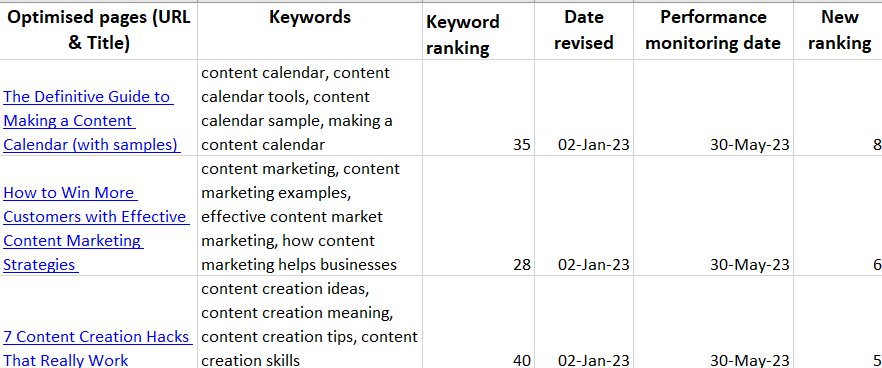Celebrated management consultant and author Peter Drucker once expressed, "If you can't measure it, you can't improve it." This principle could arguably be one of the most vital tenets in any business entity.
Intense competition compels companies to outshine and outperform rivals, particularly in the digital arena where content wields immense influence. While creating high-quality, useful, and pertinent content is crucial, it's equally significant to ensure that your audience can discover it.
In addition to crafting excellent materials, your content strategy should encompass optimal online visibility by optimizing, disseminating, repurposing, and updating them across all platforms. Once your content is published and circulated, the team must persistently assess and enhance your digital assets' performance via regular website content audits. Engaging with a proficient digital agency in Melbourne can help streamline this process.
Regular site content audits are crucial to ensure users consume your online resources and that each piece aligns with your marketing goals. In this article, you'll discover what a web content audit is, how to do it and how it impacts website growth.
Now, understand why content is crucial to website performance.
Why is Website Content Important?
Content, as they say, is king. It's your website's body and soul, giving your audience reasons to engage with your brand. Valuable, relevant and high-quality resources enable companies to attract and connect with potential customers or guide leads through the sales process.
Without blogs, product or service pages, readers wouldn't know how you can address their searches. Visitors can't decide on your brand's trustworthiness or expertise without reviews, photos and the “about us” pages. More importantly, without SEO-optimised, relevant and useful content, your webpage will remain stuck in the internet limbo, drowned by over 500,000 sites going live daily.
Content comes in many forms, including text, audio, video and images. These can be blogs, tutorial videos, product or before and after photos and infographics on your site. Format differences aside, they're created to inform, entertain, instruct or persuade the audience. Whether aiming to boost brand awareness, reliability, authority and expertise, a piece of content elicits emotions and reactions in those who consume it.
According to an A hrefs study, over 90% of websites don't get organic traffic, while only 5.7% of web pages will rank in the top 10 within one year of publication
You won't get any exposure or visibility just by relying on your website. You must publish content regularly, a digital asset your audience can find, consume, share, react to, or like. Moreover, search engine and content optimisation strategies are necessary if you don't want to get trumped by the competition.

What is a Content Audit?

A website content audit involves processes that monitor, assess and enhance your content, affecting your search engine optimisation (SEO) and marketing strategies. The first few steps entail systematically reviewing, classifying and analysing your website content to identify and address specific issues. Content types covered typically include:
- Blog posts
- Gated content (newsletters, e-books, etc.)
- Videos and images tags, and descriptions
- Landing pages
- Product or service descriptions
- External and internal site links
- Reviews and testimonials
- Frequently asked questions (FAQ) pages
A website content audit typically involves taking an inventory of your site content, evaluating its performance using specific metrics, spotting weaknesses and correcting them. For instance, a content audit for SEO might yield unimpressive results, pushing a company to rethink and revise its current optimisation strategies, content creation and marketing workflows.
Post-audit recommendations may sometimes require simple decluttering techniques, including content optimisation, repurposing, updating and removal.
According to Semrush's recent State of Content Marketing global report, 65% of companies with successful content strategies audited their content more than twice a year. Thus, it shows that web and SEO content audits help ensure your business is on track for website growth, allowing you to hit and surpass business targets.
Primary Content Audit Objectives (and Tips on What to Look For)
The timing for the content audit will depend on specific circumstances, like content migration, or certain goals, like SEO and marketing performance reviews. Scheduling a web content audit according to its purpose, such as those discussed below, makes the process more organised.
- Content Audit for SEO
The main purpose of SEO content audits is to review the website, track content performance and implement the necessary changes to increase organic traffic on every page. You may have a team capable of producing brilliant content. But without optimisation, your audience still couldn't find you, so there’s a need for an SEO boost.
Firms can group content based on its format and check how each material ranks and performs in search engines. Besides optimising website design, several elements must be reviewed under on-page, off-page and technical SEO. In some cases, local SEO would have to be factored in, especially for small businesses with physical locations.
In conducting SEO content audits, users and algorithms must be considered. Hence, you want to look at content quality and structure, specifically:
- Keyword optimisation and use
- Proper use of meta descriptions, titles, and H1 tags
- Page views
- Unique visitors
- Link profile, etc.
The end goal of this activity is to identify specific content to update, keep, optimise, and take off to improve your website performance and ranking.

- Content Audit For User Experience
Relevance and user experience are only two of the more than 200 search ranking factors, but they significantly impact how search engines evaluate pages. To grow your website and increase online visibility, focus on relevance and optimising content for your users.
Great content should be paired with usefulness and added value to encourage readers to visit your site often and to attract more leads. To check your site content for user-friendliness, check how your visitors behave in and out of the platform. Monitor user behaviour and engagement metrics, including:
- Conversion rates
- Bounce rates
- Pages per session
- Page speed
- Crawling issues
- Time spent on page or site
- Comments and mentions
- Social shares and reaction
Identify which type of content and topic generates the greatest number of user engagements, reactions and consumption. Analyse content to know which appeals to your readers and audience, and study how users interact with your site.
Understand why visitors spend too little time on other pages so you can improve these besides optimising for SEO. For instance, your content may need updating, contain too much jargon, or lack value. Discussing what your audience wants to know about engagingly can help propel or keep you on top of search pages.
- Content Audit for Marketing and Sales
Regardless of format or style, content is meant to serve a company's marketing and sales goals, both overtly and covertly. Crafting content to guide users, segmented based on their position in the sales funnel, is a good content strategy.
On top of uploading more generalised resources, creating content meant for the audience in the funnel's awareness, consideration, conversion and retention stages, makes the resources more effective. Awareness-level content is typically made of blogs, explainer videos and other formats that answer your audience's queries.
Resources for users in the consideration stage often discuss educational or how-to videos, case studies, product comparison infographics, and more. Conversion stage content, meanwhile, can be newsletters, personalised emails and the like; whereas, content that drives retention includes tips, product guides and exclusive announcements.
Various content metrics tools can be used to track content performance, so choose the ones that work best for your goals and requirements. To check whether your content is performing, study the conversion rates, reactivation or renewal rates, churn rate and customer retention rates, among other performance indicators.
How does a Content Audit Ensure Website Growth?

It's hard for companies to promote brand awareness, market their offers, and present their value proposition when the audience and potential buyers can't find them. Thus, small businesses must establish a digital presence and fill their proprietary channels with high-value and relevant content.
Doing so is a continuous discipline, considering that search engine algorithms are updated regularly. Moreover, the market is often vulnerable to changes that lead to a shift in user behaviour and preferences, making site content audits imperative for all website owners.
Content performance monitoring and optimisation ensure that your digital resources remain relevant and updated to attract and keep your audience and buyers.
Below are the most compelling reasons for conducting frequent content assessments.
- Content Audits Boost Site Traffic
By its very nature, a site content audit aims to determine content performance and make the necessary improvements. With enhancements in content quality, structure, and relevance, your website becomes more useful in the eyes of search engines and humans, increasing your brand's online visibility.
Ranking high on the search engine results pages (SERPs) is paramount to increasing web traffic, considering that the top placer gets 27.6% or more than a fourth of the total click-through rates (CTR). Additionally, the second placer gets 15.8%, while the third corners 11% of the CTRs, indicating that the top three SERP spots can already capture over 54% of organic search traffic.
That said, your brand is more likely to be discovered if your pages rank high on specific industry keywords. More users will visit your site with increased visibility to learn more about your products and services. Paired with great content, they're more inclined to revisit or share these useful resources with their network.
Want proof? The State of Content Marketing global report mentioned above had 43% of respondents saying they experienced increased web traffic after updating their content.

- Content Audits Help Secure your Site Ranking
Periodic site resource checks ensure that algorithm updates and market shifts don't pull down your rankings. As mentioned, search engines are updated frequently, and any content optimised today may rank lower with such changes in the next few months. For reference, it takes up to one year for your SEO efforts to show results, primarily depending on competition, inbound links and the content itself.
With SEO content audits, you'll discover whether your former top-performing material still enjoys search ranking prominence or if user views and consumption are slowly dipping. A quick check lets you identify the problem and prevent its further decline by making the necessary content adjustments. Hence, content audits push companies to establish a reporting and tracking system that enables online visibility through continuous digital asset optimisation.
- Content Audits Rely on Data-driven Diagnostic Tools
A content audit uses metrics derived from data analytics tools, which means it's data-driven. You can accurately identify and target specific site content that needs to be updated, improved, repurposed or removed.
Remember that your content strategy must align with your users' wants and needs, not just what you want to discuss or share with them. Through these periodic checks, you can identify your audience's most consumed content and topics, and content strategy weaknesses, then make appropriate improvements. More importantly, an audit check can help you identify gaps that improve visibility, including topic and content opportunities, missing metadata and less accurate headlines.
- A Content Audit Makes Content Optimisation Easier
A website content audit is a precursor for targeted content optimisation, allowing brands to connect with their audience and prospects more effectively.
Great content positively impacts potential consumers, cementing your trustworthiness, authority and expertise. A 2017 research by marketing firm Conductor discovered that consumers are likely to buy from a brand after reading educational content, and this positive impression increases even after a week has passed.
A separate study by SEO software company Semrush discovered that SEO, tone, consistency, readability and originality are the main pillars of high-ranking content.
Technical and structural traits aside, well-performing content can elicit certain emotions from those consuming it, affecting their impressions of the brands and their purchasing decisions.
Note that the audit doesn't end after spotting weaknesses that impact content performance but rather when the enhancements have been introduced. An upcoming site content audit will then be scheduled to determine whether these revisions worked as intended.
- An Audit Improves your Past, Current and Future Content Processes and Output
According to research, content quality was identified as the most significant content marketing factor in 2021, stressing the importance of creating materials that add value to your audience.
One good thing about having digital assets is that you can revise them based on performance and need. A site content edit determines which of your resources are serving your business well, need tweaking, and no longer working according to their purpose. By checking your online content repository, you can overhaul and improve your tactics through the following:
- Updating content information: An audit could direct you to specific resources that need to be refreshed. For instance, you can replace outdated links and facts to show up-to-date information. You can do this even with evergreen content . To the uninitiated, evergreen content is a resource that remains fresh and isn't time-bound, like how-to videos and blogs. While timeless, it can be updated to maintain usefulness. Doing so can help your pages rank better on search engines, as the algorithms favour fresh over stale content.
- Improving keyword use to boost SEO ranking: Keyword research and understanding user intent are paramount in the content creation process. With the ever-changing consumer preferences and behaviour, it pays to monitor recent keyword queries and amend your content for optimal ranking results.
- Enhancing overall SEO techniques: Besides keyword use, a content audit can pinpoint concerns in various SEO elements you need to correct immediately. These could include irrelevant and low-quality articles, broken links, missing meta tags and sitemap issues. Identifying and tweaking such errors can give you a huge visibility boost because of a site content audit.
- Refining future content creation workflows and strategies: Results from content audits provide valuable insights as to which content formats and topics work, helping you create articles that your readers are eager to consume. At the same time, regular content reviews enable you to spot weaknesses in your content creation processes, helping you avoid these weaknesses and improve your workflows.
- A Content Audit Improves Customer Site Experience
In spite of needing technical SEO to understand web pages, users remain at the front and centre of search engine results. As mentioned before, relevance and usefulness greatly impact SERPs, so your content should benefit users at the very least.
Producing great content that stirs customers' interest keeps them coming back for more. You'll know they do by tracking how users interact with your site. Readers who find your content beneficial want to stay longer and explore other useful pages on your site. They're also likely to initiate contact, comment on your post or share your site's page links with friends and family members.
These activities are trust signals for search engine algorithms, which will see your brand as an authoritative source. This, in turn, will increase your ranking exponentially.
- Content Audits Prop your Site for Sales and Revenue Opportunities

Establishing a solid connection between your materials and the product or service you're selling is vital to drive revenues from content. According to HubSpot research, about 47% of potential buyers consume up to 5 content pieces before engaging with a sales rep. Once you have a solid content strategy, you can reap business benefits, starting with content optimisation.
Appearing on top of searches will generate more leads willing to convert and eventually become paying customers. But where does a site content audit sit in the equation? Well, a web content audit helps you determine your cost per lead and per conversion, including your return on investment. From there, you can effect changes that boost revenues if you're not getting the desired results.
Concluding Thoughts
Brilliant content is key to online visibility. However, it's not enough. You might have the most insightful videos and blogs, but if your audience can't find them, they're nothing.
Getting your content strategy right has multiple benefits, especially with smart SEO tactics. Good content creation processes generate high-value pieces of content your audience loves, enhancing user experience. Search engine optimisation helps you outrank competitors and ensure your resources resonate with the right people.
Even so, such results aren't guaranteed if you don't strategically distribute and periodically analyse the impact of such pieces.
A content audit helps keep your online campaigns on the right track. With regular site content audits, you can determine whether your content strategy is aligned with your marketing and sales goals and if they're useful in turning site visitors into paying customers.
It might sound overwhelming, but with the right tools and knowledge, you're only a few steps away from owning a website that promotes higher revenues.
